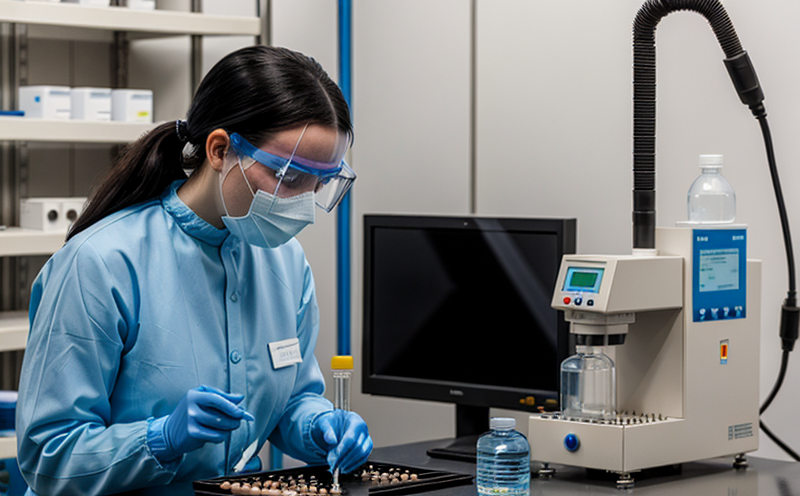Semi Volatile Organic Impurity Testing
The pharmaceutical industry places a premium on quality and safety. Semi volatile organic impurities (SVIs) are compounds that have moderate vapor pressure, meaning they can be found in both liquid and gas phases under normal conditions. These SVIs play a critical role in the formulation of drug products and their stability over time. Proper characterization and profiling of these impurities is essential for ensuring product safety, efficacy, and compliance with regulatory standards.
Our semi volatile organic impurity testing service leverages state-of-the-art analytical techniques to provide comprehensive analysis of SVIs present in pharmaceutical formulations. By identifying potential sources of contamination or degradation products early on, we help our clients maintain strict quality control measures throughout the product lifecycle. This includes ensuring that any detected SVIs meet acceptable limits set by relevant international standards such as USP, ICH, and EU guidelines.
The process begins with thorough sample preparation which may involve extraction methods like liquid-liquid partitioning or solid-phase microextraction depending on the nature of the impurity. Once prepared, samples are analyzed using advanced chromatographic techniques including high-performance liquid chromatography (HPLC) coupled with mass spectrometry (MS). This combination allows for precise separation and quantification of SVIs down to parts per million levels.
Our team of experienced scientists ensures that all tests adhere strictly to established protocols defined by regulatory bodies like FDA, EMA, and WHO. We also employ rigorous quality control measures throughout the entire testing process to ensure accurate results every time. Our commitment to excellence extends beyond just meeting compliance requirements; we strive to exceed expectations through innovative approaches tailored specifically towards addressing unique challenges faced within the pharmaceutical industry.
For instance, some drugs require extended storage periods which could potentially lead to formation of new impurities due to chemical reactions with other components in the formulation. Our testing capabilities extend far beyond simple detection – they encompass understanding how these SVIs interact with active ingredients and excipients during processing and shelf life. This knowledge is invaluable for optimizing manufacturing processes and predicting potential issues before they become problematic.
In summary, our semi volatile organic impurity testing service offers robust solutions designed to support the rigorous demands placed upon modern pharmaceuticals. Through precise analysis and expert interpretation, we empower stakeholders with critical insights necessary for maintaining high standards of quality assurance across all stages of drug development and production.
Scope and Methodology
The scope of our semi volatile organic impurity testing service includes but is not limited to the following:
- Detection, identification, and quantification of SVIs in various pharmaceutical formulations.
- Compliance with regulatory requirements such as USP, ICH, EU guidelines, FDA, EMA, WHO standards.
- Supporting R&D efforts by providing detailed impurity profiles that aid formulation optimization.
The methodology employed involves several key steps:
- Sample Preparation: Depending on the type of sample (liquid vs solid), appropriate methods for extraction, purification, and concentration are used. These might include solvent-based techniques like liquid-liquid partitioning or specialized adsorbents such as silica gel.
- Chromatographic Analysis: High-performance liquid chromatography (HPLC) is typically coupled with mass spectrometry (MS). This tandem approach allows for not only separation but also structural elucidation of SVIs based on their molecular ion fragmentation patterns observed in MS spectra.
- Data Interpretation: Our skilled analysts interpret the raw data generated from HPLC-MS analyses to determine the presence, identity, and concentration levels of each detected impurity. They then correlate these findings with known literature values or internal reference standards if available.
This comprehensive approach ensures that every aspect contributing to potential contamination risks is thoroughly examined and reported upon.
Quality and Reliability Assurance
To maintain the highest levels of quality and reliability, we adhere strictly to established protocols defined by regulatory bodies. Our services are underpinned by robust quality control measures at every stage:
- Sophisticated Instrumentation: Utilizing cutting-edge equipment such as ultra-performance liquid chromatography (UPLC), quadrupole time-of-flight mass spectrometry (Q-TOF MS), and advanced data processing software.
- Certified Personnel: Our team comprises highly trained chemists specializing in pharmaceutical analysis, ensuring accurate interpretations of complex datasets.
- Traceability: All measurements can be traced back to internationally recognized standards like ISO 17025 and ICH Q3D(E9). This guarantees consistency and repeatability across multiple analyses.
We also participate in proficiency testing programs organized by organizations such as the US National Institute of Standards and Technology (NIST) or European Co-operation for Accreditation (EA), further cementing our reputation for reliability and accuracy.
Use Cases and Application Examples
The application of semi volatile organic impurity testing spans across various scenarios within the pharmaceutical sector:
- New Drug Development: Identifying early-stage impurities helps in refining formulations to enhance drug stability.
- Process Optimization: Monitoring SVIs during manufacturing ensures optimal conditions are maintained throughout production runs.
- Patient Safety: Ensuring that no harmful SVIs exceed allowable limits protects consumers from adverse reactions.
- Regulatory Compliance: Providing documentation required for submission to regulatory agencies helps streamline approval processes.
A real-world example would be a case where a company developed an innovative formulation containing multiple active ingredients. During early stages of development, our tests revealed traces of certain SVIs that were previously unknown. Further investigation showed these impurities originated from the excipients used in the formulation. By working closely with R&D teams, we helped them modify the excipient selection process to avoid future occurrences.
This proactive approach not only improved product quality but also saved time and resources that would have been spent addressing issues later in the pipeline. Such instances underscore why comprehensive semi volatile organic impurity testing is an indispensable part of any robust quality assurance strategy.





